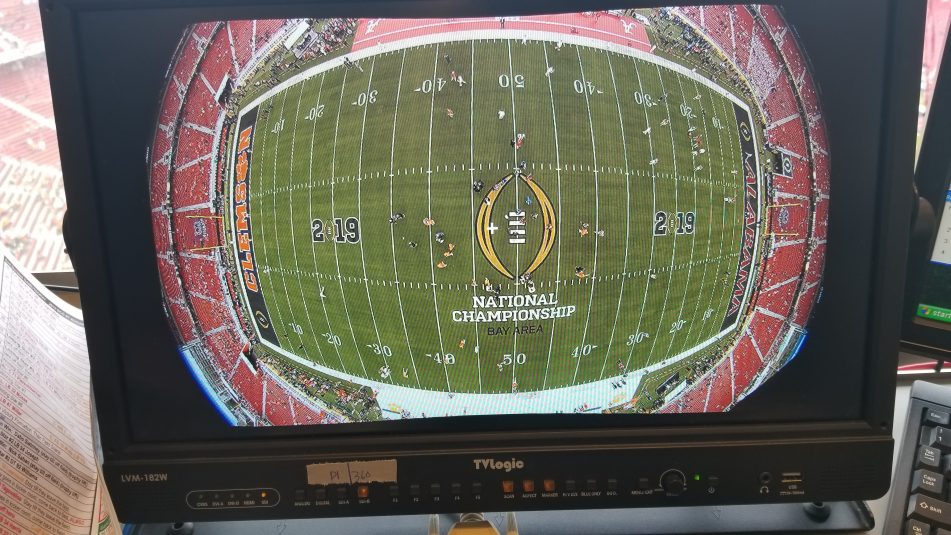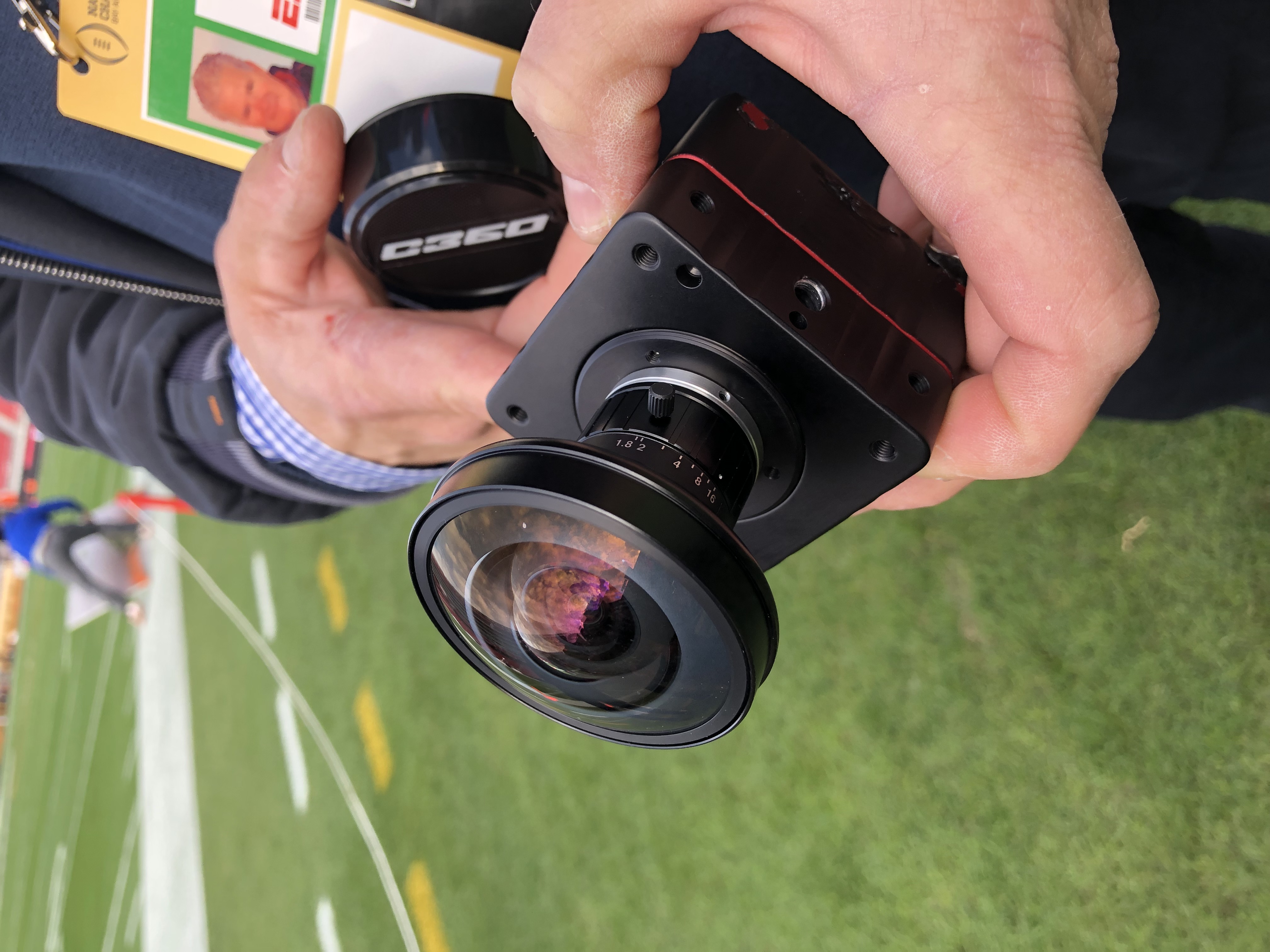Live From the 2019 CFP National Championship: First-Down–Marker Cam Upgraded; Yards-to-Gain Pylon Joins PylonCam Family
Collaboration between 3G Wireless, C360 has taken pylon and marker cameras to version 2s
Story Highlights
Robotic and RF cameras promise to play a critical role in ESPN’s production of tonight’s College Football Playoff National Championship Game (8 p.m. ET) with a tremendous technological effort enhancing a pair of CFP staples: PylonCam and the First and 10 Marker Cam.

Developed by C360 and 3G Wireless, Marker Cam has 180-degree camera embedded in the top to capture 4K images. When it debuted last year, it featured a static camera that offered producers a limited view.
There’s a total of 10 PylonCams on the field here at Levi’s Stadium for tonight’s game, including two — the Line-to-Gain PylonCams — making their National Championship Game debut. This PylonCam, the same shape as in a traditional pylon, will be carried along the field by the chain gang throughout the game, offering ESPN a direct look down the first-down line that it can call upon for replays.
Unlike the end-zone pylons, these Line-to-Gain PylonCams are wireless, producing a 1080p60 signal.
At last year’s Championship Game, the First and 10 Marker Cam operated solo. This year, the PylonCam will capture critical shots of the first-down line from a low angle, and a 180-degree camera from C360 Live will capture 4K images, a big improvement over last year’s static camera.
“We will have 4K images coming out at 33 Mbps via RF, and the nice thing is, there is a lot of cool possibilities of what can be done,” says Gordon Capaccio, director, marketing and business development, 3G Wireless. “On the backend of the camera, C360 figured out a lot of cool functionality so we can integrate it into not only OTT but the linear broadcast. It’s a pretty cool package and a great partnership.”
A production team working in Game Creek’s Nitro A unit will be able to take the 180-degree image and pan and zoom within it, extracting images that will provide a completely new look to football coverage. One of the things to look for is what happens in a goal-to-go situation. Typically, the first-and-10 markers are laid aside during that situation, but ESPN has permission to station the Marker Cam at the rear corner of the end zone.
“It’s a slash angle at a height that hasn’t existed before, as the handheld camera is typically low, with the slash [hard] camera in the stands,” says Jed Drake, consultant, C360 Live. “It’s a beautiful shot and credit to 3G Wireless because we can do what we want with the camera but, if we can’t get it home, it doesn’t matter. To me, this is one of the great stories of one plus one equaling three and disparate technologies coming together to do something that hasn’t been achievable before.”
C360 is also providing some innovation on the upper SkyCam with a second-generation camera that weighs 4 lb. and will be mounted on the bottom of the SkyCam to capture 10K shots of the field of play. As with the 180-degree camera, an operator in Nitro will be able to zoom in and extract 1080p images for use within the linear broadcast.
Stephen Wharton, SkyCam, CTO, says there are some interesting applications for the camera on the SkyCam after a play.

As the operator zooms in to this 360 image the distortion falls away and the image appear as if it is a normal SkyCam shot.
“This can be incorporated as a live camera but the real appeal is being able to go back in time and control the output,” he says. “The next phase will be multiple outputs with an iso on the wide receiver, an iso on a linebacker, and an iso on the quarterback and then playing it in realtime or as a replay. It’s the start of something interesting.”
Capaccio sees the potential for a pole-mounted C360 camera to go beyond the First and 10 Marker Cam.
“The flexibility of going RF gives you some of those opportunities like getting into a fan section and being immersive,” he says. “We are looking at a number of other places it can be used because it’s possible. We have a palette, and now we just need to figure out some good uses for it.”
ESPN aims to work its PylonCams collaboratively with its robust 360-degree–camera system deployed here. Made up of 160 4K DSLR cameras, the system — designed by San Francisco-based 4DReplay — offers quick turnaround on full sweeping replays of action anywhere in the stadium.

The new Yard-to-Gain PylonCam will be carried along by the chain gang during the game. Its case contains a single camera pointing down the line, unlike its goal-line counterparts, which contain multiple lenses.
ESPN Senior Coordinating Producer Ed Placey acknowledges that, although the various PylonCams and yard-marker cameras offer unprecedented views of the field, even they have limitations. He cites this season’s Clemson–Texas A&M game, when officials were unable to get a clear view of a disputed Aggies touchdown that came in directly over a goal-line pylon.
“None of the angles that we had — and we had great angles — could be pieced together and sequenced clearly enough that you could tell that the ball was fumbled right over the top of the pylon or not,” says Placey. “It dramatically impacted what the call was. We need to find ways to answer these questions and to forensically assess these pylon plays that have their own set of unusual and unique rules.”
With an enhanced cluster of those 160 cameras focused on the pylons on each goal line, ESPN aims to have the necessary view should an important call need to be made.

